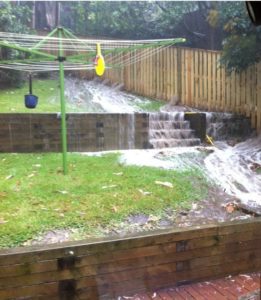What are the obligations of neighbouring landowners in respect of overland water flow in the context of a retaining wall that separates them.
A higher landowner is not liable merely because surface water flows naturally from his land on to the neighbour’s lower land.
 Only if they carry out works that causes water to flow in a more concentrated form than it naturally would, can the higher landowner carry any potential liability for nuisance.
Only if they carry out works that causes water to flow in a more concentrated form than it naturally would, can the higher landowner carry any potential liability for nuisance.
Consider the case of Sunshine Coast landowner Dr Flaviu Alic and his wife Nona who constructed their residence near Kiel Mountain in Diddillibah in 2015.
Their large semi-rural allotment is elevated well above that of their northern neighbours – Drs Philip Graham and Naomi Sunderland – who took up residence in June 2017.
The Alics cut into the natural slope of the land on the southern side of their block and used about 800 m3 of the resulting fill on the northern side to create an across-the-block house pad.
The descent from the pool area on their northern side down to the ground level of the Graham-Sunderland parcel is 5-6 m .
A 2 m high timber sleeper retaining wall that runs 52 m along the Alecs’ side of boundary, sits below two battered slopes separated by a flat area that add a further 2 – 3 m to the escarpment.
Dr Graham believed the 2015 construction of his neighbours’ home and the boundary escarpment changed the water flow into his property.
This was exacerbated – he claimed – when in 2018 about 60m3 of topsoil was added above the retaining wall to extend the flat area on the Alic’s side and move the top edge of the batter closer to the boundary and steepen its slope.
As a consequence, he constructed some works to redirect stormwater run-off away from the foundations of their home.
Notwithstanding those works, prolonged rain events still caused a substantial amount of soil, mud, sand and grass seed washed down the batter and over and through the sleepers to pond around their shed and residence.
He and Dr Sunderland decided to file a lawsuit in the District Court seeking an injunction to compel the removal and reconstruction of the retaining wall as well as damages comprised by the cost of the remedial works they had performed and other expenses including for turf replacement.
They did not contend the volume of overall flow had been increased, but rather that the placing of fill and installation of the retaining wall without effective drainage increased the concentration and velocity of the water.
The matter came before Judge Rowan Jackson in April.
He observed that even before the Alics built their home and the retaining wall – well before the Grahams owned their property – the natural flow appeared to have been a significant issue.
That said, it was apparent that the batters and wall did concentrate the flow and increase its velocity of travel into the Graham-Sunderland allotment.
Such concentrated flow was not, His Honour concluded, a result of the natural use of the Alics’ land because the steep slope so close to the boundary without appropriate drainage – namely broken ag-pipe that hadn’t been effectively installed to start with – was not a natural and reasonable use of the land.
In arriving at that conclusion, he noted expert evidence that the footings of the retaining wall were at an inappropriately shallow depth with posts that clearly of insufficient depth and height.
Judge Jackson accepted the evidence of engineer Donald Stanfield that it would be more economical to demolish the wall and rebuild it than to try and fix the drainage and that regardless, ag-pipe could not be effectively positioned without demolishing the wall.
“It would be economically more sensible to proceed with the replacement of the wall,” His Honour observed before ordering Dr Alic and his wife be required to demolish the timber sleeper wall and replace it at their expense with a wall “designed and built according to plans approved and certified by an engineer nominated by the president of Board of Professional Engineers of Queensland” with sufficient drainage to “abate the nuisance” constituted by the concentrated water flow.
Dr Graham’s remedial works constructed in 2020, were in Justice Jackson’s view “sensible precautionary steps for a downhill neighbour to take” and remedied the inadequate but measures installed by his predecessor in title.
Because they “simply constitute good building practice when a flat building platform is to cut below the natural height of the land” he dismissed his claim for reimbursement of the cost of those works.
Graham & Anor v Alic & Anor [2022] QDC 106 Jackson QC DCJ, 28 April 2022




0 Comments